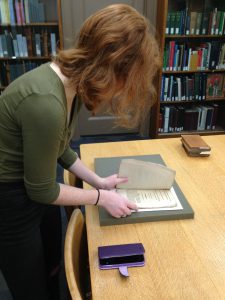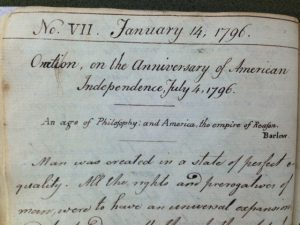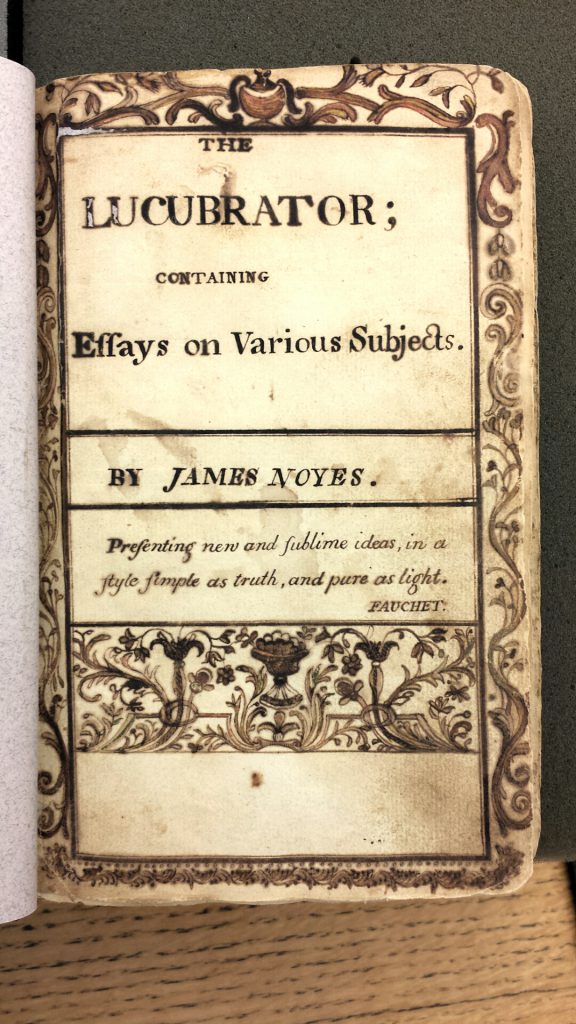To celebrate the first week of classes, we're sharing a series of student work completed last semester. Students in Dr. Juliette Paul's English 4300 class undertook a transcription and research project on an early American manuscript that has been in our collections for decades, but that we knew very little about. We'll share their discoveries and insights here over the next nine weeks. -KH
by Emma Quinn
 People often forget about the multitude of manuscripts that are forever lost, which is why discovering one previously unknown seems all the more incredible. Unearthing a mysterious manuscript entitled The Lucubrator (1794-97) is exactly what our class did this semester (English 4300, Spring 2016). As we studied early American literature, it made sense for us to examine the strange, little-known manuscript held in our Special Collections and Rare Books Library. Filled with essays illustrating the culture of the early United States, The Lucubrator seems to belong to the literature we studied. We believe the manuscript was once owned by James Noyes (1778-99), a young, patriotic, and accomplished New England writer whose name appears on the title page.
People often forget about the multitude of manuscripts that are forever lost, which is why discovering one previously unknown seems all the more incredible. Unearthing a mysterious manuscript entitled The Lucubrator (1794-97) is exactly what our class did this semester (English 4300, Spring 2016). As we studied early American literature, it made sense for us to examine the strange, little-known manuscript held in our Special Collections and Rare Books Library. Filled with essays illustrating the culture of the early United States, The Lucubrator seems to belong to the literature we studied. We believe the manuscript was once owned by James Noyes (1778-99), a young, patriotic, and accomplished New England writer whose name appears on the title page.
The University of Missouri’s copy of The Lucubrator is the only one known in the world. It consists of essays dated between 1794 and 1797 and includes titled such as “On the Planets being inhabited worlds,” “Oration on the American Independence,” and “Reflections on the Month of December.” The experience of studying the manuscript felt almost unreal—to be the first group of students to study a one-of-a-kind, handwritten, and heartfelt text. I was amazed to think that a real historical person had carved his pen ink into the delicate curled letters of the manuscript, and transcribed his thoughts and opinions into the form of essays, creating the book that we can now hold in the palm of one hand. Studying the faded and cracking pages in Special Collections made the author and his or her writings feel so much more present and real to me. How did the manuscript get here? Who was James Noyes, and why did he decide to write The Lucubrator, if he is indeed the author?
These are the questions we looked to answer; and it seems very likely that we have answered some of them. We can now imagine who James Noyes might have been and what he and other authors of his time liked to study, what their society was like, and what they aimed to accomplish during their lifetimes. We have found evidence that the manuscript was written in America; its author celebrates the creation of the United States, makes use of the American spellings of words, and quotes from a book published only in Philadelphia when the entry was made.[1]
We also discovered how important The Lucubrator’s essays were—both culturally and historically in the eighteenth century. For example, in the essay “On Female Education,” the author argues that women have similar rights to knowledge as men. Though this idea is not revolutionary today, it was so after the American Revolution. This manuscript might remind us that thinking differently can catch on and change an entire culture.

[1] The epigraph in the essay “On Female Education” is taken from James Neal’s An Essay on the Education and Genius of the Female Sex (Philadelphia, 1795).
